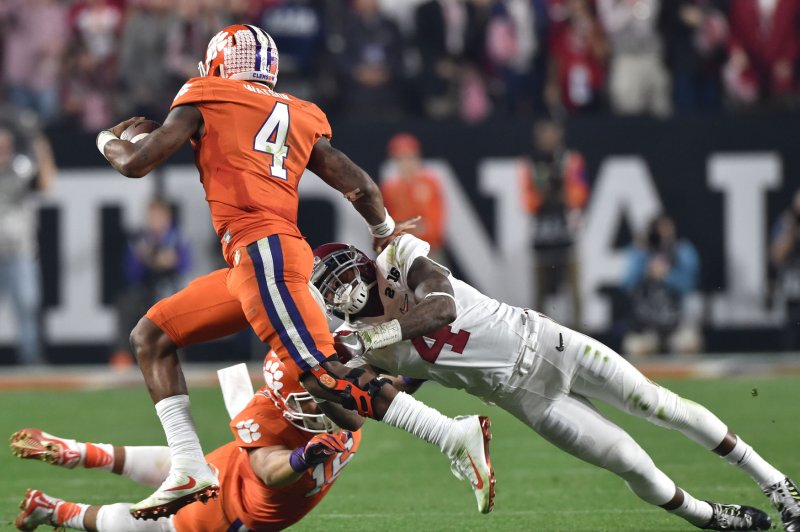Researchers at Boston University say the accumulation of many smaller impacts contribute to the development of CTE more than number of concussions over many years of playing football. Pictured, Clemson Tigers quarterback Deshaun Watson, at left, eludes a tackle by Alabama safety Eddie Jackson in the third quarter of the 2016 College Football Playoff National Championship on January 11, 2016. File photo by Jon SooHoo/UPI |
License Photo
BOSTON, April 1 (UPI) -- While repeated concussions pose a significant danger to football players, researchers at Boston University suggest in a new study that the overall number of impacts to the head is a much greater risk to players' future health.
A lot of attention has been paid to football players sustaining multiple concussions over the course of a career, increasing their risk for chronic traumatic encephalopathy, but the new study says coaches, doctors and parents are ignoring the risk of thousands of other impacts sustained during practice and play.
By calculating the number of hits a player takes over the course of their career, the researchers said a much better idea of CTE risk could be predicted. At the same time, the researchers say thresholds set in the study for analysis aren't necessarily safe thresholds because each person's body reacts differently to getting hit.
The overall message of the study, the researchers say, is that hitting one's head over and over again has long-term consequences.
"I think of the study as just the beginning of trying to characterize exposure in a more precise way," Michael McClean, a researchers of public health at Boston University, told the New York Times.
For the study, published in the Journal of Neurotrauma, researchers estimated the total number of times 93 former high school and college football players, between the ages of 24 and 82, sustained during their careers.
To determine each players Cumulative Head Impact Exposure Index, or CHII, the researchers considered number of seasons played, what positions were played, level of play and research from impact frequencies in previous helmet accelerometer studies.
The mean score among the players was 7,742 impacts, with many who had a higher score on the CHII showing more cognitive, mood and behavioral effects. Thresholds were established to display levels of risk -- going from 6,500 hits to 12,000 increases risk for cognitive impairment by 25 times -- but they do not establish safety, researchers said.
The researchers say more studies are needed to determine the relevance and accuracy of the CHII, but they do not question that subconcussive impacts, considered in the study as one that causes the head to snap more forcefully than what is approximately caused by jumping.
"The number of hits that are found to serve as a threshold are not meant to be interpreted as, 'Wow, I've reached that magic number, so I should stop,'" Robert Stern, a professor of neurology at Boston University, told the Washington Post. "There is no magic single number for any given individual. There might be some people who have many, many times the number of hits and do just fine later in life. And there may be many people who have far fewer hits and experience significant problems later in life."















